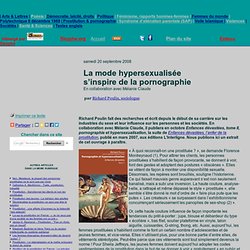

Sexisme chez Disney Studios. Capsules vidéos sur l’hypersexualisation – Girls Talk: The Sexualization of Girls. Christine Reuter Starr Research on Girls and Sex Appeal. Christine Reuter Starr, at right, covering a school story for a newspaper internship in 2009; at left, examples of the "sexy" and "non-sexy" doll illustrations shown to girls in the study.

Research conducted at Knox College, which began as a senior psychology project by Christine Reuter Starr '10, is gaining national and international attention as the first study to show that girls as young as six identify themselves as sex objects. Starr, who now works as a medical research assistant, and her faculty advisor, professor Gail Ferguson, co-authored the report, published in the journal Sex Roles. Starr interviewed 60 girls between ages six and nine, showing them pictures of two dolls, one doll dressed in "sexy" clothes, and the other doll wearing modest but still trendy clothes. On liberal media analysis of “The Sexualization of Young Girls” Video from Sociological Images.

We have seen before that liberal media analysis consistently falls short of making meaningful political connections, or naming and explaining the foundations and mechanisms of male power. The point of liberal and even liberal feminist media criticism seems to be to merely point out various “inequalities” or perceived positional slights and to conclude that these inequalities are undesirable on their face — for example, pointing out that young girls are sexualized more than are young boys suggests that the statistical difference is significant without explaining why that is so, or how or even whether it is of political relevance to women and feminists. What we have here is interesting, because the video itself does not even claim to be an examination of the sexualization of young girls in the media — the title of the project is “Media Sexualization of Children.”
La mode hypersexualisée s’inspire de la pornographie. Richard Poulin fait des recherches et écrit depuis le début de sa carrière sur les industries du sexe et leur influence sur les personnes et les sociétés.

En collaboration avec Mélanie Claude, il publiera en octobre Enfances dévastées, tome II, pornographie et hypersexualisation, la suite de Enfances dévastées, l’enfer de la prostitution, publié en mars 2007, aux éditions L’Interligne. Nous publions ici un extrait de cet ouvrage à paraître. Hypersexualisation des fillettes. Too Sexy, Too Soon. In our sexed-up society, can a new pro-girl movement help your daughter resist the call to be too sexy, too soon?

They're spray tanned. They're body waxed. They're wearing high heels in kindergarten. And increasingly in the online world, girls are choosing to represent themselves with sexy photos and videos. Everyone knows that marketers will do anything to get people to spend money -- especially impressionable young kids. "Increasingly over the past 10 years, we've seen an escalation in the sexualization of young girls," says Deborah Tolman, professor of social welfare and psychology and founding director of the ASAP Initiative, which does research and analysis of sexuality for action and policy. Fighting Back Tolman is part of a coalition of authors, academics, filmmakers, and celebrities like Geena Davis -- who leads the Geena Davis Institute on Gender in Media -- that's fighting back against a media and marketing drumbeat of sex, sex, sex.
Providing Options. Why 6-Year-Old Girls Want to Be Sexy. Most girls as young as 6 are already beginning to think of themselves as sex objects, according to a new study of elementary school-age kids in the Midwest. Researchers have shown in the past that women and teens think of themselves in sexually objectified terms, but the new study is the first to identify self-sexualization in young girls. The study, published online July 6 in the journal Sex Roles, also identified factors that protect girls from objectifying themselves. Psychologists at Knox College in Galesburg, Ill., used paper dolls to assess self-sexualization in 6- to 9-year-old girls. Sixty girls were shown two dolls, one dressed in tight and revealing "sexy" clothes and the other wearing a trendy but covered-up, loose outfit.
Using a different set of dolls for each question, the researchers then asked each girl to choose the doll that: looked like herself, looked how she wanted to look, was the popular girl in school, she wanted to play with. Pourquoi les petites filles veulent-elles "être sexy" ?#.UA2QHdSn1uc.twitter. Pondu par Justine_ le 23 juillet 2012.

How the Media Affects Your Daughter and What You Can Do to Help. Most 10 year-olds have been on a diet: study; 53 percent of 13-year-old girls have issues with how their bodies look. Louis Fox/Getty Images Data show that about 80 percent of 10-year-olds have dieted at one point in their lives.

The desire to diet has no age minimum, a new study shows. Approximately 80 percent of all 10-year-old girls have dieted at least once in their lives, according to recent data released by the Keep It Real campaign. The campaign, which aims to improve body-image issues in young adults , drew the staggering statistic from a study by Kimberly Hepworth, titled “Eating Disorders Today — Not Just a Girl Thing.” Ads for Keep It Real also state that 53 percent of 13-year-old girls have issues with how their bodies look, a percentage that rises to 78 percent when girls turn 17.
Research by the National Eating Disorders Association (NEDA) confirms Keep It Real’s numbers. Between 40 to 60 percent of children age 6 to 12 are worried about how much they weigh, and 70 percent would like to slim down. “I’ve seen a girl as young as 8 years old on a feeding tube, Grefe told CBS Seattle. These Little Girls Are Asking The Most Devastating Question I Can Imagine.
Les jeunes filles veulent un corps imberbe. Recevez nos newsletters : Quatre filles sur cinq veulent changer quelque chose à leur corps et plus de la moitié entament un régime avant l’été par peur du bourrelet malheureux et de la fesse molle sur la plage.

Vidéo : les femmes et les hommes poupées. Les femmes poupées. Il n’y a pas si longtemps j’ai entendu Rufus lisant une lettre écrite par une femme fontaine.

C’était sur France Culture et c’était un extrait d’un spectacle qu’il donne ou va donner. Mystère, étrangeté, mythe, ce phénomène est suffisamment passionnant pour donner envie qu’on lui dédie une œuvre d’art vivant. Je me dis du coup qu’il y aurait peut-être quelque chose à créer du côté de celles qu’on appelle les femmes poupées. C’est justement une femme médecin esthétique qui en parle dans la vidéo que vous allez voir. Heureuse ou paradoxale association qui tendrait à prouver que : - Le fait d’être également une femme ne rend pas subjectif - La chirurgie plastique qu’elle soit française ou internationale n’est pas qu’une machine à fric et que le jugement de tempérance et de réserve y existe également. Oui parce que ce médecin y est dans ses mots et dans la tonalité de son commentaire très critique à l’égard de ce phénomène. Les "attention whores" ou "l'échec du féminisme"
Ces dernières années ont émergé des lolitas du web, aussi appelées "attention whores", soit des adolescentes prêtes à tout pour se faire remarquer.
